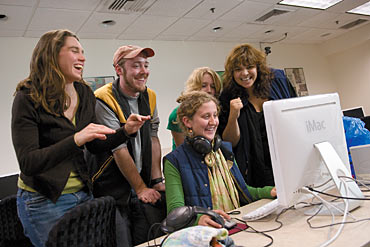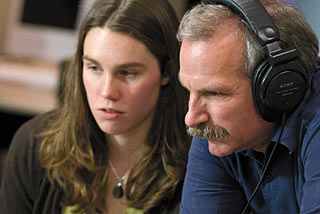New classes explore environmental film’s mobilizing power
Gregg Mitman believes in the power of a well-told story. He should — he’s living proof that a good story, told with passion and heart, can influence an audience.
Trailer samples
View a sampling of the trailers that will screen at the Tales From Planet Earth Film Festival.
This is a video story that requires the Flash 8 or higher player plugin. Download and install it.
I’m In a Badger State of Mind
A totemic cult so big, you have to talk to the high priests of Badgerdom to understand.
Director: Peter Boger, M.S. student in land resources
This is a video story that requires the Flash 8 or higher player plugin. Download and install it.
For When the Buffalo Return
A meditative look at prairie restoration by any means necessary.
Director: Jesse Clayton Mursky-Fuller, sophomore biology major
This is a video story that requires the Flash 8 or higher player plugin. Download and install it.
Fish Fry
The tradition, the fish, the lakes…the ocean?
Director: Amrys O. Williams, Ph.D. candidate, history of science
As a youngster, he was enthralled by the 1960s television programs “The Undersea World of Jacques Cousteau” and “Flipper.” That early enthusiasm led to a degree in biology and graduate degrees in the history of science.
Today, Mitman is the William Coleman Professor of History of Science and professor of medical history and science and technology studies, and director of the Center for Culture, History and Environment in the Nelson Institute for Environmental Studies. He teaches courses on the history of ecology, and the history of environment and global health.
This semester, though, Mitman is teaching two new courses on the environment from a cinematic perspective: a class on environmental film in history and a hands-on production class in documentary storytelling.
When environmental filmmaking is done right, says Mitman, the artistry can engage an audience, create hope and inspire mobilization — a contrast to the defeated hopelessness and despair of many environmental documentaries.
“I want to open up what we think is a good environmental film and how we might tell other types of stories to change our interactions and attitudes,” says Mitman. “Leonardo DiCaprio’s recent film ‘The 11th Hour’ had so much gloom and doom. Good stories should mobilize our interests into actions.”
On hand to help Mitman teach the classes are two celebrated and award-winning environmental filmmakers. Judith Helfand, Arts Institute artist in residence, makes films that grapple with issues of social justice; Sarita Siegel, special guest artist, makes wildlife documentaries that tell stories of what happens to the underdog when cultures collide.
Like Mitman, Helfand was inspired by a story well told. She saw the documentary “The Weavers: Wasn’t That a Time” on television in the 1980s. In the film, Pete Seeger talked about art in the service of activism. Smitten with his message and the power of nonfiction film, Helfand started down a path of documentary making that told stories in support of justice, equality and the environment.
Siegel admits to becoming obsessed with film while in college and watching everything she could. With a background in anthropology and religious studies, she understands the complexity of social networks and how they are interconnected with culture and the environment. Her mission is to drill down to the emotional truth of a story.
Together, the three are challenging their students to consider what exactly an environmental film is, and then to find their own voice and vision, hoist up a camera and create transformative films.
It’s a pretty tall order for a class of nonfilmmakers.
Helfand teaches film to aspiring filmmakers at New York University. This is her first venture with inexperienced filmmakers, but she’s not worried. “We’re asking a lot of them, but I have complete faith,” she says. “They are incredibly smart and willing to take risks. I don’t want them to be freaked out by what they don’t know. They are using so much, but as they need it.”
“Documentary Storytelling: Nonfiction Storytelling in Pictures, Moving and Still: The Basics and Beyond” is a high-intensity documentary boot camp. The students are expected to learn how to use a camera, frame shots, edit footage, use sound and music, and “get” the interview — all while exploring how we shape and interact with the environment. Those tools are found in the Digital Media Center in the Genetics-Biotechnology Center. The film work, they hope, will articulate their good visual stories into art that challenges our notions of environment, nature and science.
“The students are learning by doing — that’s how I learned,” says Siegel. “The class has a level of nervous energy, but that’s how you live as a filmmaker.”
After the nuts-and-bolts aspects of learning to use a camera and sophisticated editing software are well in hand, the artistry enters. For a documentary to be effective, Helfand says, it must have high stakes: a relationship worth fighting for and a heart at risk of being broken. “Without heart and character, it’s just a lens and a camera. I want to teach the students to make moving moving pictures,” Helfand says.
For the first project, students were hit head-on with their notions of home and the environment. They were given pollution reports for their home zip codes and asked to produce a short film that explored their cultural, social and material relationships to that environment. The exercise was designed to teach the fundamentals of using a mini digital video camera and editing, but the films revealed a richer, deeper awareness of the subject than the instructors expected.
“I was happy with how great the first projects were. It was a real experiment, but we see the voices of the students in their films,” says Helfand. “They are all experts in their own fields, but are learning a new language and medium here. They are totally rising to the occasion.”
Mitman agrees. “I was thrilled with the first projects. I had no idea they’d come out so well. The students are giving 150 percent,” says Mitman. “This class is a once-in-a-lifetime opportunity. They are getting a lot of exposure to working artists.”
As if the combined talents and experience of Helfand and Siegel weren’t enough, the guest artists called upon friends and colleagues to help out. The students learned about cinematography, post-production sound and editing from additional distinguished teachers and filmmakers.
Class member and graduate student Peter Boger heard the call of the wild watching nature films as a child and decided to answer. Studying in the Nelson Institute’s Land Resources Program, he hopes to graduate in May 2008, although his participation in the film production class may have him playing catch-up next semester.
“This class has been all-consuming in a good way. We’re working at such a breakneck pace there hasn’t been time to process everything. It will be nice to pause and reflect,” Boger says. “I’ve always been interested in film and what convinces people to care. This was such an unbelievable opportunity — I would have been crazy to say ‘no.’ I don’t care if my thesis gets written.”

Artist in residence Judith Helfand, far right, works with students, left to right, Amrys Williams, Peter Boger, Kathleen Masterson, seated, and Kirsta Rasmussen on their “Tales From Planet Earth” environmental film projects in a computer lab in the Genetics-Biotechnology Center.
Photo: Jeff Miller
The second assignment sent them to the Dane County Farmers’ Market to produce a profile of a vendor.
The training wheels came off for the class for a project currently in production. Each student is to produce a two-minute trailer on “What’s so Natural About Wisconsin?” Topics being explored include a carbon-neutral bed and breakfast, Madison’s bike culture, invasive species, Wisconsin’s Friday night tradition of fish fries and Boger’s exploration of what a furry team mascot, Bucky Badger, has to do with Wisconsin’s mining past.
The trailers will be shown at the Tales From Planet Earth Film Festival at the Orpheum Theatre, 216 State St., on Friday, Nov. 2, before the Madison premiere of the film “Everything’s Cool” at 7:45 p.m.
“I’m petrified to see my work at the festival on the big screen,” says Boger, who hopes eventually to teach environmental history or ethics, or work in a zoo or museum setting. “Everything is magnified. On the computer screen a slight shake is not a big deal.”
Mitman will not be spared from the big screen jitters; he is making a trailer on heritage turkeys, which will also be shown before “Everything’s Cool.”

Professor Gregg Mitman works with graduate student Amrys Williams as she makes final edits to her environmental film project. “Good stories should mobilize our interests into actions,” says Mitman, who this semester is teaching a class on the role of environmental film in history and a hands-on production class in documentary storytelling.
Photo: Jeff Miller
“I am really jazzed by the students and seeing them engage full-on. I’m anxious to see what happens after the trailer assignment. It will be a bit of a pause and graduation before we move ahead,” says Helfand.
For a final project, the students will apply all they have learned to produce a short feature that experiments with the very advanced cinema topics of form, style, content, intent and tone.
After the course wraps, the instructors hope the students are inspired to make more environmental films with emotional truth that mobilize interests into actions.
“To go from an idea to an articulated story is pretty complicated,” says Helfand. “But the only thing that can come out of this class is something great and real.”




